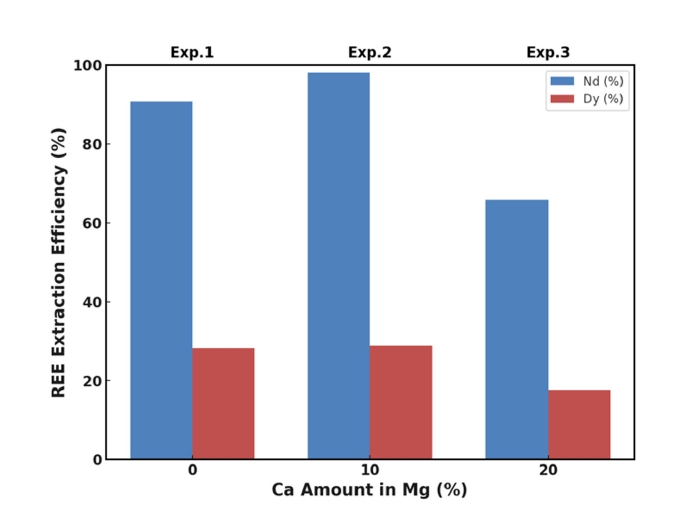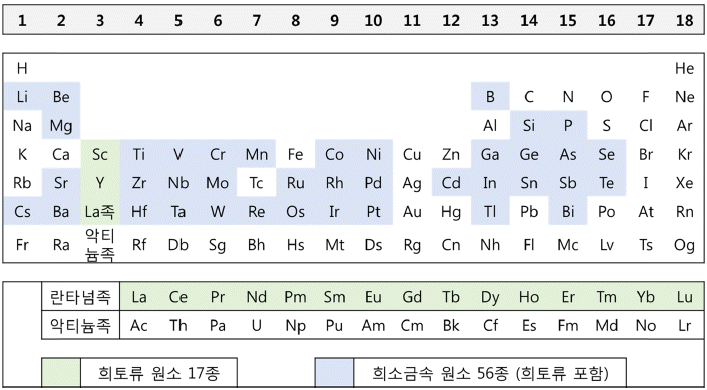Search
- Page Path
- HOME > Search
- [English]
- Effect of Calcium Addition on the High-Temperature Recovery of Nd and Dy from Nd-Fe-B Scrap Using Mg-Based Extractants
- Hyoseop Kim
- J Powder Mater. 2024;31(6):493-499. Published online December 31, 2024
- DOI: https://doi.org/10.4150/jpm.2024.00283

- 644 View
- 14 Download
-
 Abstract
Abstract
 PDF
PDF - This study investigated whether calcium (Ca) addition improved the recovery of neodymium (Nd) and dysprosium (Dy) from Nd-Fe-B magnet scrap using magnesium (Mg)-based liquid metal extraction (LME). Traditional LME processes are limited to temperatures up to 850 °C due to oxidation issues, reducing the efficiency of rare earth element (REE) recovery, especially for Dy. By adding 10 wt.% Ca to Mg and increasing the processing temperature to 1,000 °C, we achieved nearly 100% Nd and approximately 38% Dy recovery, compared to 91% and 28%, respectively, with pure Mg at 850 °C. However, excessive Ca addition (20 wt.%) decreased the recovery efficiency due to the formation of stable intermetallic compounds. These results highlight the critical role of Ca in optimizing REE recycling from Nd-Fe-B magnet scrap.
- [Korean]
- Standardization Status of Rare Earth Elements Recycling in ISO TC 298
- Mi Hye Lee, Yosep Song, Ji Sun On, Seung Hwan Yoon, Munhwan Han, Bum Sung Kim, Taek-soo Kim, Bin Lee
- J Powder Mater. 2022;29(2):159-165. Published online April 1, 2022
- DOI: https://doi.org/10.4150/KPMI.2022.29.2.159

- 754 View
- 22 Download
-
 Abstract
Abstract
 PDF
PDF Rare earth elements, which are important components of motors, are in high demand and thus constantly get more expensive. This tendency is driven by the growth of the electric vehicle market, as well as environmental issues associated with rare-earth metal manufacturing. TC 298 of the ISO manages standardization in the areas of rare-earth recycling, measurement, and sustainability. Korea, a resource-poor country, is working on international standardization projects that focus on recycling and encouraging the domestic adoption of international standards. ITU-T has previously issued recommendations regarding the recycling of rare-earth metals from e-waste. ISO TC 298 expands on the previous recommendations and standards for promoting the recycling industry. Recycling-related rare earth standards and drafts covered by ISO TC 298, as well as Korea’s strategies, are reviewed and discussed in this article.
- [Korean]
- Standardization of Rare Earth Elements in ISO TC 298 and Korea's Standardization Strategy
- Nu Si A Eom, Sardar Farhat Abbas, Haq Muhammad Aneeq, Rasheed Mohammad Zarar, Mi Hye Lee, Bum Sung Kim, Taek-Soo Kim, Bin Lee
- J Korean Powder Metall Inst. 2019;26(3):251-257. Published online June 1, 2019
- DOI: https://doi.org/10.4150/KPMI.2019.26.3.251

- 666 View
- 3 Download
-
 Abstract
Abstract
 PDF
PDF Since the ISO decided to deal with rare-earth elements at the 298th Technical Committee (TC) in 2015, Korea has participated in four plenary meetings and proposed four standards as of June 2019. The status of ISO TC 298, the standards covered by the TC, and the standardization strategies of Korea are summarized. Korean delegations are actively engaged in WG2, which deals with recycling, proposing four standards for fostering the rare-earth recycling industry. However, the participation of domestic experts is still low compared with the increase in the number of working groups and the number of standards in TC 298. The aim of this article is to summarize the current status of ISO international standards related to rare-earth elements, to encourage relevant experts to participate in standardization, and to develop international standards that accurately reflect the realities of the industry.
TOP
 kpmi
kpmi

 First
First Prev
Prev


